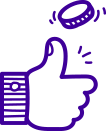Planning and budgeting may seem tedious or stressful, but the peace of mind you’ll have when you know where you’re money is going (and how much you’re saving) is priceless. We’ll go over the basics and give our best planning and budgeting recommendations and money-saving tips, so you can enjoy the relief of financial wellness. Let’s get started...
Bank Account Management
Before we get into personal bank account management, it’s good to have an understanding of how banks work.
Banks are very different from other businesses. Essentially, banks pay their customers to lend them money which is used to create loans and other lines of credit. Banks earn interest on those loans, and pass some of the profits on to their customers by paying interest on the money they have stored in the bank—frequently in savings accounts, but often in checking accounts too.
What does that mean for you? It means that banking is a mutually beneficial transaction, and you deserve to reap the benefits of being a bank account holder.
Choosing a bank account
Bank accounts are not “one size fits all.” Banks offer a variety of accounts to suit their customers’ unique needs. What is the right fit for you? Here’s a breakdown:
CHECKING ACCOUNTS
Checking accounts are the most accessible of all bank account types. With a checking account, you’re able to deposit and withdraw money as needed. Deposits can be made in the form of cash, paper checks, or automatic transfers. Cash can be withdrawn, transferred, or spent on items using checks or a debit card.
There are several varieties of checking accounts:
- Basic checking accounts are the most commonly used checking account. Typically, this kind of account has few restrictions on balance minimums, number of transactions allowed, etc.
- Business checking accounts have features such as multiple debit cards for employees and extra security precautions.
- Rewards checking accounts offer earnings on money stored within the account. Rewards checking account interest rates average between .04% and 1%. Some rewards checking accounts have an even higher APY (annual percentage yield).
- Joint checking accounts can be accessed by multiple individuals, such as a couple who share finances. The benefits of a joint bank account are that you can easily track household funds and simplify your budgeting efforts.
- Student checking accounts cater to first-time bankers such as teens and college students. These accounts tend to have fewer fees than basic checking accounts and low (or no) minimum balance requirements.

SAVINGS ACCOUNTS
This type of account encourages you to leave your money in the account. One of the benefits of saving money is that you can earn interest. As outlined earlier, banks rely on customer deposits to fund their business activities, so they will pay interest on money that is held in their accounts. Similarly, savings accounts are structured to discourage withdrawals.
Here are the most common types of savings accounts:
- Basic savings accounts are simple accounts that offer moderate APYs and limit withdrawals.
- Money market accounts offer more freedom on withdrawals and spending, but typically have high minimum balance requirements

Certificates of Deposit (CDs) pay more in interest than basic savings or money market accounts, but have more restrictions. With a CD, you’ll agree to lock up your money for a period of time (or pay a penalty for early withdrawal)








